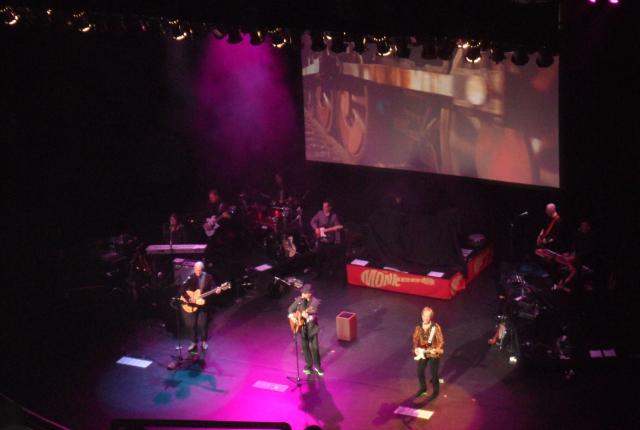
Thousands of eager fans gathered at the Beacon Theatre for the final show of the “An Evening with the Monkees” tour featuring Micky Dolenz, Peter Tork, and Michael Nesmith. The three musicians had not performed together in the U.S. since 1969, and this was the first tour after the death of singer Davy Jones, who unfortunately passed away from a heart attack this past February.
While it was a bold move to tour without Jones, the three remaining members stuck to the motto “the show must go on” and put on a spectacular performance that pleased every Monkees fan.
The crowd was a very diverse mix: devoted fans who watched the Monkees TV show when it first aired in 1966, young adults and children who came along with their parents, and then there’s that high school journalist. However, no matter what age, everyone in the crowd was grooving and singing along throughout the Monkees’ 29- song set comprised of their hits as well as many songs from the “Headquarters” and “Head” records.
The show started off with clips from the Monkees TV show including classic Monkees Kellogg’s commercials that set the clock back to the 1960s in the theatre. Then, the lights dimmed, and the backing band came out and played a medley of classic Monkees tunes, including the very catchy “(Theme From) The Monkees.”
Finally, Dolenz, Nesmith, and Tork took to the stage, and the audience jumped out of their seats as Nesmith played the first notes of “Last Train to Clarksville.” The energy level didn’t drop one bit for the rest of the night.
During the show, Dolenz proved that he is not only a great singer but also a great frontman as well. He was constantly moving around trying to energize the crowd, especially during “I’m Not Your Stepping Stone.” Before “I’m a Believer,” he joked with the younger audience in the crowd, “We sang this song long before Shrek!” When he wasn’t busy running around the stage, Dolenz was either singing while playing the acoustic guitar or playing percussion on the cajon and the drums.
Tork was in top form as well, switching between numerous instruments such as the guitar, bass, keyboards, and even banjo. He even had his chance to show off his singing -and dancing- abilities in “Your Auntie Grizelda.” His slide-shuffle dance was pretty good, and it had all of the women in the crowd cheering.
Nesmith fit right in with the band even though he hadn’t been in it for over 40 years. He was one of the prominent songwriters for the band, and his work was showcased throughout the evening with performances such as “You Just May Be The One,” “Goin’ Down,” and “Sunny Girlfriend.” Although he wasn’t as active as the others, he took control of his own zone as he sang and played guitar.
Jones may not have been at the show, but he was definitely there in spirit. There were many tributes to him, including video clips of the songs he sang on such as “I Wanna Be Free” and “Daddy’s Song.” However, the most touching tribute to him was during the performance of Jones’s biggest hit with the band, “Daydream Believer.” Dolenz, Nesmith, and Tork felt that they were unable to sing the song, so they handed the microphone over to a lucky fan and let the audience sing this timeless hit. It was one of the happiest and the saddest moments in my life- a concert experience that I will never forget.
From the first notes of “Last Train to Clarksville” to the last strums of “Pleasant Valley Sunday,” the Monkees captivated the audience with a performance that had even the severely arthritis-stricken individuals dancing and clapping along the whole show.
It was a night celebrating the history of the Monkees- the show and the band.
The three Monkees still had the same chemistry that was surely there back in the 60s, and they were all having fun playing with each other. Jokes and stories filled in the gaps between songs, keeping the atmosphere of the show loose and lively.
Having seen the three remaining Monkees still smiling and dancing on stage while having fun performing with each other, I left the Beacon Theatre that night knowing one reassuring fact- after all of these years, the Monkees are still the Monkees.
